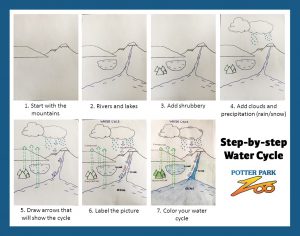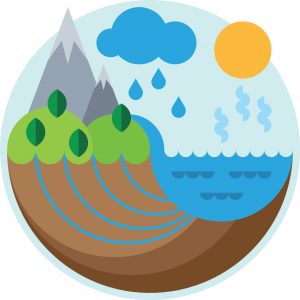Water is essential for all living things. Earth’s supply of water is finite – the total amount of water on our planet never changes. What does change is where the water is and what state it is in (solid, liquid, or gas). The water cycle is a description of how water moves and changes states.

Draw your own water cycle with this step by step instruction
Transpiration is the process of water movement through a plant and its evaporation from leaves, stems and flowers. Plants use water for the photosynthesis process and bring minerals up from the soil through the roots.
Evaporation is when water changes from a liquid to a gas. For example, water can be evaporated from lakes, rivers and the ocean by energy from the sun. As the evaporated water is warmed, the water vapor rises into the air.
Condensation happens when water vapor converts back into liquid water by cooling. This is how clouds are formed. The parts of clouds we see are made up of water droplets and ice crystals.
Precipitation occurs when condensation of water builds up and becomes very heavy. The condensed water is then released in the form of rain, hail or snow.
Runoff is water from rain and other sources that flow over a land surface. As the runoff flows along the surface of the ground, it will pick up and carry along soil particles and any contaminants present as it flows into rivers, lakes, and oceans.
 We all rely on water for survival. Animals drink water from puddles, rivers, creeks, and lakes. Here in the US, about 40% of Americans rely on groundwater (wells) for drinking, and the rest get theirs from surface water. Surface water covers 70 percent of the earth!
We all rely on water for survival. Animals drink water from puddles, rivers, creeks, and lakes. Here in the US, about 40% of Americans rely on groundwater (wells) for drinking, and the rest get theirs from surface water. Surface water covers 70 percent of the earth!
Since we all depend on water, it is important to keep our water clean. Pollution can come from chemicals, nutrients, and heavy metals from farms, factories, transportation and other human activities.
Plastic pollution is an especially important problem which we all contribute to. Once plastic gets in to our waterways, it breaks down into micro-plastics. These micro-plastics are harmful to both plants and animals.
Reducing, reusing and recycling plastic reduces pollution and makes our water cleaner and safer!




